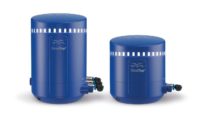Enhanced Meat Satisfying Customer Needs
By Bryan Salvage, Editorial Director
Pork holds the pole position in this category.
Adding value is a major driver in the ongoing evolution of meat and poultry products. And when it comes to adding value, just about every pork processor, but a far smaller yet growing number of beef processors, offer enhanced meat.
If unclear on just what exactly enhanced meat is, the Hormel Foods glossary of meat terms explains: “A meat product that has received injections of water, salt, and sodium phosphate to season the meat and to keep it from drying out. As meat producers increasingly raise leaner animals that contain significantly less fat, alternative processes are being developed to replace the flavor and moisture loss due to the reduction in fat on the animal. Enhancing the meat is one such process.”
Major processors offering enhanced meat include Smithfield’s John Morrell & Co., which claims to be the first meat company to establish a successful brand -- John Morrell Tender N Juicy--in the enhanced fresh pork category. And its Butcher Shop Enhanced Variety Meats allow retailers to order those cuts that will meet unique customer demand and ethnic populations.
Once considered a specialty product, it’s safe to say that enhanced pork has joined the mainstream.
“Every pork packer I can think of offers a line of enhanced products – Hormel Always Tender, Farmland Extra Tender Pork, Smithfield Lean Generation, etc.,” says Karen Boillot, director of retail marketing, National Pork Board.
Hormel Always Tender brand pork is made from a patented tenderizing process, made only from the finest cuts of meat, and feature consistent flavor and texture, the company explains. Flavored products in this line include Peppercorn Tenderloin, Teriyaki Tenderloin, Lemon Garlic Filet, Mesquite Barbecue Filet, Honey Mustard Filet, Mojo Filet, Peppercorn Chops, Teriyaki Chops, Onion & Garlic Roast, and Roast Flavored Roast.
But enhanced products are by no means exclusive only to pork. When visiting meat departments during research for the National Meat Case Study 2004 (NMCS), which was funded by The Beef Checkoff Program, in partnership with the National Pork Board, and Cryovac/Sealed Air, the research team found quite a bit of value-added fresh beef, primarily flavored product, says Randy Irion, director of retail marketing, the National Cattlemen’s Beef Association (NCBA).
“But it represents a fairly small part of the total beef business,” he adds.
“We offer meat that has been marinated and/or injected to add flavor --- and in some cases to enhance the texture,” says John J. Rattigan Jr. director, marketing & business development, Colorado Boxed Beef Co., Auburndale, FL., which offers beef, pork, poultry, lamb, veal, seafood, cheese, lunch meat, and a variety of fresh, frozen, and dry products.
Beneath the surface
Based on NMCS study results, most enhanced products at retail are not value-added (i.e., flavor or ingredient added). Here’s how the protein groups break down in descending order of enhanced percentages:
| Protein Group | % Enhanced |
| Pork | 35 percent |
| Chicken |
|
| Beef | 13 percent |
|
| 6 percent |
And here’s how the protein groups break down in descending order of enhanced value-added percentages:
| Protein Group | % Enhanced Value-Added |
| Pork | 10 percent |
|
| 6 percent |
|
| 3 percent |
|
| 3 percent |
The benefits of enhanced meat are numerous. The process enhances tenderness, flavor, and moisture; allows more convenient products for retailers and foodservice operators; extends shelf-life and improves food safety; promotes better color and moisture retention; reduces purge and rancidity, among other things.
“From a retail perspective, enhanced products offer consumers items that can actually be overcooked and still provide a good, consistent eating experience,” Boillot says. “For foodservice, enhanced products hold better -- providing a juicy product despite varied holding times/temperatures. Flavored products also offer foodservice operators some flavor profiles to use in various menu applications.”
| Most enhanced Product was not value-added | |||
| Charts Based on percentage of packages with in Species | |||
| Beef (Whole Muscle) | Non-Enhanced | Non-Enhanced | Total |
| Not Value Added | 83% | 13% | 96% |
| Value Added | 1% | 3% | 4% |
| Total | 84% | 16% | 100% |
| Chicken | Non-Enhanced | Non-Enhanced | Total |
| Not Value Added | 75% | 19% | 94% |
| Value Added | 2% | 4% | 6% |
| Total | 77% | 23% | 100% |
| Pork | Non-Enhanced | Non-Enhanced | Total |
| Not Value Added | 53% | 35% | 88% |
| Value Added | 2% | 10% | 12% |
| Total | 55% | 45% | 100% |
| Turkey | Non-Enhanced | Non-Enhanced | Total |
| Not Value Added | 86% | 6% | 92% |
| Value Added | 2% | 6% | 8% |
| Total | 88% | 12% | 100% |
| ``Enhanced`` = Moisture Added, Value AddeD = flavor or ingredient added Source: NMCS 2004 | |||
“Many foodservice operations have to hold product,” Irion adds. “That’s a sure way to dry product out. Having enhanced product will reduce that problem.” At the foodservice level, cooking skills become less critical when preparing enhanced meat.
Product can be overcooked a little longer without damaging the overall quality, and the shelf-life benefit is also important.
From a retailer standpoint, enhanced meat improves yield and shelf-life, and serves as a value-added step to deliver flavor. In beef, the enhancement process particularly benefits leaner cuts when cooked to a higher temperature.
“Beef is consistently tender and juicy when it is properly cooked, but a lot of people like their beef well-done. This is where enhancement can be a benefit,” Irion says. “We’ve learned that in some communities, Hispanic in particular, people tend to cook their meat to higher temperatures.”
Although the enhancement process works wonders on leaner cuts, in particular, processors must also be careful not to over-enhance their products.
“You can make a product too moist and too tender,” Irion warns. “You don’t want to take all of the texture away.”
Looking ahead
What does the future hold for enhanced meat? The answer depends on a retailer’s goals and objectives, as well as the understanding of his customer base, NPB’s Boillot says.
“While enhanced products are very popular, retailers are also experimenting with other alternatives or the addition of a secondary line that is natural product,” she says.
Enhanced beef will most likely continue to grow, Irion predicts.
“I’m not expecting [enhanced beef] to grow by leaps and bounds, but a lot of case-ready product is enhanced and value-added, and we know that case-ready continues to make inroads. And with case-ready, we’re extremely interested in improving shelf-life. [Enhancing meat] is another way to accomplish this goal.”
No doubt, various segments of the foodservice industry will rely more on enhanced meat to provide unique flavor differences over the competition, as well as to ensure meat entrées aren’t rendered unacceptable by diners if overcooked by the kitchen staff.
Enhanced meat products have im-proved in recent years, says Rattigan, and further improvement is very likely.
“There are a tremendous amount of ingredients being tested, and that category should continue to grow as technology improves and the wide varieties of ingredients being tested make it to market,” Rattigan concludes. NP




Report Abusive Comment